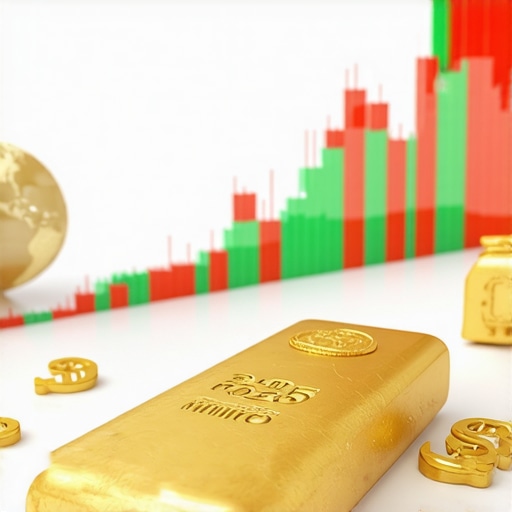Introduction to Gold Demand Trends
The dynamics of gold demand are influenced by various factors, making it a topic of keen interest for investors and market analysts alike. Understanding these trends is crucial, especially as we look towards 2025. The gold market is often viewed as a barometer for global economic health and geopolitical stability. As uncertainties rise and fall, so does the demand for gold, reflecting its status as a safe-haven asset.
Factors Influencing Gold Demand
Several key factors shape the demand for gold. Firstly, geopolitical tensions can drive investors towards gold as a secure investment. Events such as trade wars, conflicts, or political instability often lead to increased purchases of gold, as investors seek to protect their wealth. In 2025, we anticipate continued fluctuations in these geopolitical factors, which will affect gold prices and demand.
Another significant driver is central bank policies. Central banks around the world hold substantial gold reserves and often adjust these holdings based on economic conditions. If central banks increase their gold purchases, it typically signals a lack of confidence in other assets, which can further enhance demand. For insight into how these factors may play out, check our post on gold market analysis and predictions.
Investment Trends in Gold
As we approach 2025, it is essential to consider the evolving investment trends in gold. The rise of gold ETFs and mutual funds has made gold investment more accessible to a broader audience. This trend is expected to continue, as new investors seek easy entry points into the gold market. Understanding these investment vehicles is vital for anyone looking to capitalize on gold’s potential benefits.
Gold as a Hedge Against Inflation
In an era of rising inflation, many investors view gold as a hedge against currency devaluation. As inflation rates rise, the purchasing power of fiat currencies diminishes, making gold an attractive alternative. In 2025, we expect that inflation concerns will persist, further driving demand for gold as investors seek stability. For further insights, explore our article on accurate gold price forecasts.
Emerging Markets and Gold Demand
Emerging markets, particularly in Asia, are also significant contributors to gold demand. Countries like China and India have a long-standing cultural affinity for gold, particularly in jewelry and investment. As these economies grow, their demand for gold is likely to increase, impacting global supply and demand dynamics. Understanding these regional trends will be essential for making informed investment decisions in 2025.
Gold Demand in Investment Portfolios
As investors continue to navigate the complexities of the financial landscape, gold’s role in investment portfolios becomes increasingly prominent. The diversification benefits of gold are well-documented; it often performs well during market volatility, making it an essential asset for risk management. Many investors are incorporating gold into their portfolios not only for its potential to preserve wealth but also to counterbalance equities and bonds. For those looking to explore more about integrating gold into their investment strategies, consider reading our guide on effective gold investment strategies.
Gold Demand Trends in Jewelry
The jewelry sector remains a significant driver of gold demand, particularly in regions where gold holds cultural significance. In countries like India, gold jewelry is not merely a fashion statement but a symbol of wealth and status, especially during festive seasons and weddings. As we move toward 2025, the jewelry market in emerging economies is expected to expand, further solidifying gold’s position as a desirable asset. Understanding the nuances of this demand can provide valuable insights for potential investors.
Technological Innovations and Gold Demand
Technological advancements are also shaping gold demand. The rise of gold recycling and innovations in mining technology are making gold extraction more efficient. This can influence supply dynamics, potentially stabilizing prices and affecting overall demand. Investors should keep an eye on these developments as they may present opportunities for strategic investments in gold-related sectors. For a deeper dive into the technological aspects, refer to our post on gold market analysis and trends.
Global Economic Factors Impacting Gold Demand
Understanding the global economic landscape is crucial for predicting gold demand trends. Factors such as interest rates, inflation, and currency fluctuations can significantly impact gold prices. For instance, when interest rates are low, gold becomes more attractive as an investment compared to interest-bearing assets. As we approach 2025, analysts anticipate various economic conditions that may influence these factors, making it essential for investors to stay informed. For further insights, check out our article on gold price forecasts.
The Role of Gold in Investment Strategies
Incorporating gold into an investment strategy requires understanding its unique attributes. Unlike stocks or bonds, gold does not generate income; however, it can act as a hedge against inflation and currency devaluation. As traditional investments face increased volatility, many are turning to gold as a reliable option. This aspect is particularly relevant in 2025, where economic uncertainty may prompt more investors to consider gold as a safeguard for their portfolios. Explore our guide on evaluating gold investment performance for more detailed strategies.
Looking Ahead: The Future of Gold Demand
As we continue to explore gold demand trends, it is evident that multiple factors will shape its future. From cultural significance in jewelry to its role in investment portfolios, gold remains a versatile asset. Investors should remain vigilant and adaptable, keeping abreast of market developments and economic indicators. The upcoming years promise to bring shifts in demand dynamics, making ongoing analysis essential for informed decision-making. With awareness of these trends, one can strategically position themselves for success in gold investments.
Understanding Gold Demand Trends in the Jewelry Sector
The jewelry market plays a pivotal role in shaping gold demand trends, particularly in regions where gold holds cultural significance. Countries like India and China are notable for their deep-rooted traditions of gifting and wearing gold, especially during weddings and festivals. As we approach 2025, the growth of the middle class in these regions will likely enhance demand, reinforcing gold’s status as a coveted asset. For investors, recognizing these regional dynamics is essential for informed purchasing decisions. To delve deeper into the cultural aspects of gold, consider exploring our guide on understanding types of gold investments.
The Impact of Technological Advancements on Gold Demand
Technological advancements are revolutionizing the gold market in various ways, influencing both supply and demand. Innovations in mining technologies and gold recycling processes are enhancing the efficiency of gold extraction, which can stabilize supply and potentially affect pricing. Moreover, the rise of digital platforms for trading gold has made investing more accessible, attracting a younger demographic eager to incorporate gold into their portfolios. This shift in trading dynamics is crucial for investors to monitor as they consider strategies for capitalizing on emerging opportunities. For further insights on trading techniques, check out our post on gold trading techniques.
Global Economic Indicators and Their Influence on Gold Demand
When assessing gold demand, it is essential to consider the broader global economic indicators. Factors such as inflation rates, currency fluctuations, and geopolitical stability can profoundly impact investor sentiment towards gold. For instance, during periods of economic uncertainty, many investors flock to gold, viewing it as a safe haven. As we head into 2025, vigilance regarding these indicators will help investors anticipate market movements and adjust their strategies accordingly. For a comprehensive analysis of upcoming economic trends, refer to our article on key factors influencing gold prices.
Gold Demand in Investment Strategies: A Comprehensive Approach
Incorporating gold into an investment strategy requires a nuanced understanding of its characteristics. Gold does not generate income like stocks or bonds; however, it serves as a reliable hedge against inflation and economic volatility. This aspect is particularly pertinent in 2025, where economic uncertainties may prompt more investors to consider gold as a stabilizing asset within their portfolios. For those looking to refine their gold investment strategies, our guide on top gold investment tips offers valuable insights.
Emerging Trends in Gold Investment Vehicles
The rise of gold investment vehicles, such as ETFs and mutual funds, has transformed how investors interact with the gold market. These products allow for easier entry into gold investment, catering to both novice and seasoned investors. As the demand for these vehicles grows, understanding their mechanics and benefits becomes crucial for maximizing returns. Investors should remain informed about the evolving landscape of gold investments, including potential regulatory changes that could impact these vehicles. For more on this topic, check out our article on navigating gold ETFs and mutual funds.
Looking Ahead: Factors Shaping Gold Demand
As we look towards 2025, it is clear that a multitude of factors will continue to shape gold demand. From geopolitical tensions to technological advancements and evolving consumer preferences, staying informed is vital for investors aiming to capitalize on gold’s potential benefits. With the landscape constantly changing, ongoing research and adaptability will be key to navigating the complexities of gold investments. For those eager to stay ahead of the curve, our upcoming content will delve deeper into specific strategies and predictions for gold investments in the near future.
Emerging Trends in Gold Investment Vehicles
The landscape of gold investment is evolving rapidly, particularly with the advent of innovative financial products. Gold investment vehicles, such as exchange-traded funds (ETFs) and mutual funds, have surged in popularity, providing investors with diversified exposure to gold without the need for physical ownership. These vehicles cater to both new and seasoned investors, making gold accessible to a larger audience. As we approach 2025, understanding the mechanics and benefits of these products is essential for maximizing returns in the gold market. For insights on navigating these investment options, consider our article on navigating gold ETFs and mutual funds.
The Impact of Regulatory Changes on Gold Investments
As the gold investment landscape shifts, regulatory changes can significantly impact how these investment vehicles operate. Investors must stay informed about any legislative alterations that may affect taxes, fees, or compliance requirements. In 2025, we anticipate that regulatory bodies will continue to refine the framework governing gold investments, which could influence investor behavior and market dynamics. For a comprehensive understanding of these regulatory aspects, refer to our insights on gold market analysis.
Gold Demand Trends in Emerging Economies
Emerging markets are at the forefront of the gold demand narrative, particularly as their economies continue to grow. Countries such as India and China are witnessing a robust increase in gold consumption, driven by cultural traditions and rising disposable incomes. As we look at 2025, the demand for gold in these regions is expected to remain strong, significantly impacting global supply chains. Investors focusing on these markets should be aware of the cultural significance of gold, especially during festivals and weddings, as it drives consistent demand. To better understand these dynamics, explore our guide on understanding gold demand trends.
The Role of Gold in Sustainable Investing
Sustainability is becoming a central theme in investment strategies across various sectors, including gold. Investors are increasingly interested in the ethical implications of their investments, particularly concerning environmental and social governance (ESG) criteria. The rise of responsible gold mining practices and gold recycling is reshaping perceptions of gold investments. By prioritizing sustainability, investors can align their portfolios with their values while still capitalizing on gold’s potential as a safe-haven asset. For more on sustainable investing in gold, consider reading our post on enhancing your physical gold investments.
Technological Innovations Shaping Gold Investment
Technology continues to play a pivotal role in transforming the gold market. Innovations such as blockchain technology are revolutionizing how gold is traded, providing greater transparency and security. Additionally, advancements in mining technologies are improving the efficiency of gold extraction, potentially stabilizing supply and influencing pricing. Investors should keep pace with these technological trends, as they may present opportunities for strategic investments in gold-related sectors. For a deeper dive into the impact of technology on gold trading, refer to our article on gold trading techniques.
Conclusion: Preparing for the Future of Gold Investments
As we navigate the complexities of the gold market, understanding the emerging trends and dynamics is crucial for making informed investment decisions. From the rise of investment vehicles and the impact of regulatory changes to the growing demand in emerging economies, multiple factors will shape the future of gold investments. By staying informed and adaptable, investors can strategically position themselves for success in the evolving landscape of gold.
Comprehensive FAQ Section on Gold Demand Trends
What factors influence gold demand in 2025?
Gold demand in 2025 will be influenced by geopolitical tensions, central bank policies, inflation rates, and technological advancements. Understanding these factors helps investors navigate the gold market more effectively.
How does inflation affect gold prices?
Inflation often drives gold prices up, as investors seek gold as a hedge against currency devaluation. When inflation rises, the purchasing power of fiat currencies declines, making gold a more attractive investment option.
Why is gold considered a safe-haven asset?
Gold is viewed as a safe-haven asset due to its intrinsic value and historical stability during times of economic uncertainty. Investors flock to gold during crises, which can increase its demand and price.
What role do emerging markets play in gold demand?
Emerging markets, especially in Asia, significantly contribute to gold demand. Countries like China and India have strong cultural ties to gold, particularly in jewelry. As their economies grow, their demand for gold is expected to rise.
How can investors incorporate gold into their portfolios?
Investors can incorporate gold into their portfolios through direct purchases of physical gold, gold ETFs, mutual funds, or mining stocks. Diversifying with gold can help mitigate risks associated with traditional investments.
What are the benefits of investing in gold ETFs?
Gold ETFs offer investors a liquid and cost-effective way to gain exposure to gold without the need for physical storage. They provide diversification and are typically more accessible than physical gold investments.
What should investors consider about gold recycling?
Gold recycling has become an important factor in the gold supply chain, contributing to sustainability. Investors should consider how recycled gold impacts market dynamics and pricing, particularly in the context of growing demand.
How do technological innovations affect gold mining?
Technological innovations in gold mining increase efficiency and reduce costs, potentially stabilizing supply and influencing prices. Investors should monitor these advancements as they can create new opportunities in the gold market.
What trends should investors watch for in the gold market?
Investors should watch for trends such as rising gold demand in emerging economies, changes in central bank policies, evolving investment vehicles like ETFs, and the impact of regulatory changes on gold investments.
Authority Resources for Further Learning
For those looking to deepen their understanding of gold demand trends and investment strategies, the following resources provide valuable insights:
- World Gold Council – Offers extensive research and reports on gold market trends and demand.
- Investing.com – Provides market analysis and forecasts related to gold and other commodities.
- Forbes Gold Articles – Features expert opinions and articles on gold investments and market dynamics.
- Bloomberg – A leading source for financial news, including gold market insights and analysis.
- MarketWatch – Offers updates and commentary on gold prices and market movements.
Conclusion: Preparing for the Future of Gold Investments
In summary, understanding gold demand trends is essential for investors seeking to navigate the complexities of the market. With the interplay of various factors such as geopolitical tensions, inflation, and emerging markets, staying informed and adaptable is crucial. By leveraging the insights presented in this article and utilizing authority resources, investors can position themselves for success in the evolving landscape of gold investments as we approach 2025. Gold remains a versatile and valuable asset, and recognizing its potential can lead to informed and strategic investment decisions.










The post does a great job highlighting how geopolitical tensions and central bank policies are pivotal in shaping gold demand, especially as we approach 2025. From my experience following gold markets, these factors truly serve as early warning signals. For instance, when central banks begin to amass more gold reserves, it often reflects shifts in global confidence away from traditional currencies. I also appreciate the emphasis on gold ETFs — they have democratized gold investment, letting smaller investors participate without physical gold holding hassles.
One aspect I’ve been curious about is how emerging market demand, especially from culturally driven jewelry purchases in India and China, may interact with the growing popularity of gold ETFs. Do you think as more investors in these regions turn to financial products over physical gold, it might change the conventional demand dynamics? Additionally, with inflation expected to remain a concern, gold’s status as a hedge continues to be relevant but perhaps complicated by interest rate fluctuations globally.
It would be interesting to hear other readers’ perspectives on balancing physical gold investments versus ETFs or mutual funds in uncertain economic times. Have any of you shifted your strategy recently in response to these evolving factors?